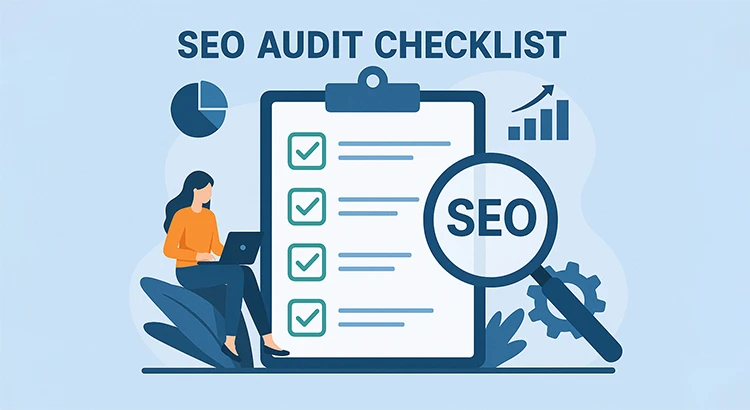An effective SEO audit checklist helps identify the technical and content-based issues that may be holding back your website visibility. Whether you’re refining an existing site or working on a fresh optimization plan, reviewing each point ensures your page is in the best shape to improve rankings and attract more traffic.
Comprehensive SEO Audit Checklist
Follow this detailed process to evaluate and improve every part of your site’s performance, from content quality to mobile usability and link structure.
1. Check Your Organic Traffic
Begin by analyzing how much search-driven traffic your website currently receives. Use platforms like Google Analytics and Search Console to review month-over-month and year-over-year trends. Pay close attention to key pages, traffic sources, bounce rates, and keyword performance. A sudden drop in visits might signal a penalty, indexing issue, or technical error. Likewise, consistent stagnation could indicate poor content performance or lack of authority in your niche.
2. Run a Full Site Crawl
Running a full site crawl helps you evaluate the technical health of your website. This process identifies issues such as broken links, duplicate content, missing metadata, or incorrect redirects. It ensures that search engines can crawl and index your site effectively, removing any obstacles that could hinder your site’s visibility and performance in SERPs.
3. Improve Your On-Page SEO
Each page should have a clear focus, meaningful material, and a structure that guides both readers and search engines. Evaluate your titles, headings, meta descriptions, image alt attributes, and keyword usage. Are your headings aligned with the content? Is each section targeting a specific user intent? Beyond keywords, focus on delivering real value to users, aligning copy with what people are searching for and ensuring easy readability.
The best SEO companies optimize on-page elements to enhance user experience and help your site rank higher in SERPs by aligning it with search intent and best practices.
4. Maximize Your Internal Links
Internal links strengthen your site’s architecture by guiding users (and bots) from one relevant page to another. This helps distribute link equity and highlight priority content. Audit your internal linking strategy to ensure important pages are getting sufficient internal references. Avoid orphan pages, and use descriptive anchor texts to improve both relevance and usability.
5. Optimize for UX Signals
User experience affects how long visitors stay, how many pages they view, and whether they convert. These behavioral signals influence your site’s credibility in SERPs. Improve layout clarity, typography, and interactive elements. Streamline navigation, avoid intrusive pop-ups, and ensure call-to-actions are visible and intuitive. Focus on making the journey seamless for visitors on both desktop and mobile.
6. Optimize for Featured Snippets
To capture prominent positions in SERPs, craft material that directly answers common questions. Use clear structures: bullet points, numbered lists, and concise definitions. Identify queries where featured results appear, and reshape your material to align with those formats. Aim to become the most helpful, quick-to-digest result for users looking for immediate answers.
7. Check Page Rendering
Rendering is how search engines process and display your material. JavaScript-heavy sites, complex CSS, or blocked resources can interfere with this process. Use Google Search Console’s URL inspection tool or mobile-friendly testing tools to see how your page is rendered. Compare what users see with what bots see to ensure nothing important is being missed during the crawling process.
8. Ensure Your Site Is Mobile-Friendly
With mobile-first indexing in full effect, your website must perform flawlessly on smartphones. Conduct mobile usability tests to spot issues with layout, font size, tap targets, or slow-loading assets. Responsive design should be standard, but real-world testing across multiple devices is essential to uncover hidden issues.
9. Check Google Is Indexing Your Site Correctly
Not all your pages may be indexed, and that’s not always a problem—unless important material is missing. Use the “site:yourdomain.com” search operator to get a sense of what’s visible. Then use Search Console’s Coverage report to find page URLs that are excluded or marked as “discovered, not indexed.” Address indexing barriers like canonical errors, accidental noindex tags, or low-value content.
10. Speed Up Your Site (Core Web Vitals)
Page speed impacts both user satisfaction and your site visibility. Google’s Core Web Vitals focus on real-world metrics like loading performance, interactivity, and visual stability. Compress images, use lazy loading, eliminate render-blocking scripts, and implement caching strategies. Fast-loading pages reduce bounce rates and improve engagement.
11. Remove “Zombie Pages”
These are outdated, low-value, or irrelevant pages that add no value to your website and can dilute your authority. Identify and prune these by reviewing traffic data and engagement metrics. Either delete them, combine them with stronger material, or improve them significantly. A leaner site with stronger material performs better in organic search.
12. Find and Fix Indexing Problems
Even if pages are technically fine, they may not be visible in SERPs due to indexing errors. Audit your robots.txt, sitemap, canonical tags, and internal links. Make sure your important pages are accessible to crawlers and aren’t being blocked unintentionally. Resolve issues like duplicate content or inconsistent redirects that might confuse search engines.
13. Fix Broken Links
Broken internal or outbound links negatively affect both user trust and crawlability. Regularly check for 404 errors and fix them by redirecting, updating, or removing links. A smooth linking experience ensures visitors (and bots) stay engaged and reach the intended destinations.
14. Perform a Backlink Audit
Review your website’s link profile using tools like Ahrefs or Google Search Console. Identify and disavow toxic or irrelevant links that may harm your rankings. Check for broken backlinks and redirect them to relevant pages. Focus on strengthening connections with high-authority sites to build credibility and improve your website’s trustworthiness in Google.
15. Analyze Your Competitors
Understanding what top-performing sites in your industry are doing gives you direction. Examine their content topics, keyword targeting, backlink profiles, and overall structure. Are there topics they cover more thoroughly? Do they have more engaging formats? Use this insight to adjust your own approach and find opportunities they may have missed.
16. Find Opportunities to Create 10x Better Content
Review your top pages and compare them to competitors ranking above you. Can your material be made clearer, longer, more insightful, or better designed? Think about the user intent and aim to deliver an experience that is dramatically better than what currently exists. This mindset is crucial for long-term growth and authority.
17. Audit Your Structured Data
Structured data helps Google understand your content and can enhance listings with rich snippets. Use Schema.org markup for articles, products, reviews, FAQs, and more. Validate your implementation using Google’s Rich Results Test. Correct errors or missing fields to improve the chance of enhanced search presentation.
18. Set Up Keyword Rank Tracking
Track how your material performs in SERPs over time. Keyword rank tracking tools let you monitor gains, identify declining terms, and evaluate which content strategies are working. This data is invaluable for ongoing optimization and helps you respond proactively to algorithm updates or ranking shifts.
19. Analyze Your Site’s Topical Authority
Authority comes from depth and coverage. Organize your content into clusters around key themes. Link related pages together and ensure they cover different subtopics thoroughly. This helps build expertise and sends strong relevance signals to Google.
20. Think About Information Gain
Go beyond surface-level content by offering unique insights, original data, or expert perspectives. Search engines reward pages that add real value, not just repeat what’s already available. Analyze top-ranking results, find what’s missing, and fill those gaps. Adding fresh angles or deeper explanations can help improve relevance and strengthen your site’s authority.
Summary
A well-structured SEO audit checklist helps you uncover hidden issues affecting your website’s performance. By evaluating technical elements, user experience, content quality, indexing, and backlink profiles, you create a solid foundation for long-term ranking improvements. Following this process ensures your site stays optimized, competitive, and aligned with search engine expectations.


